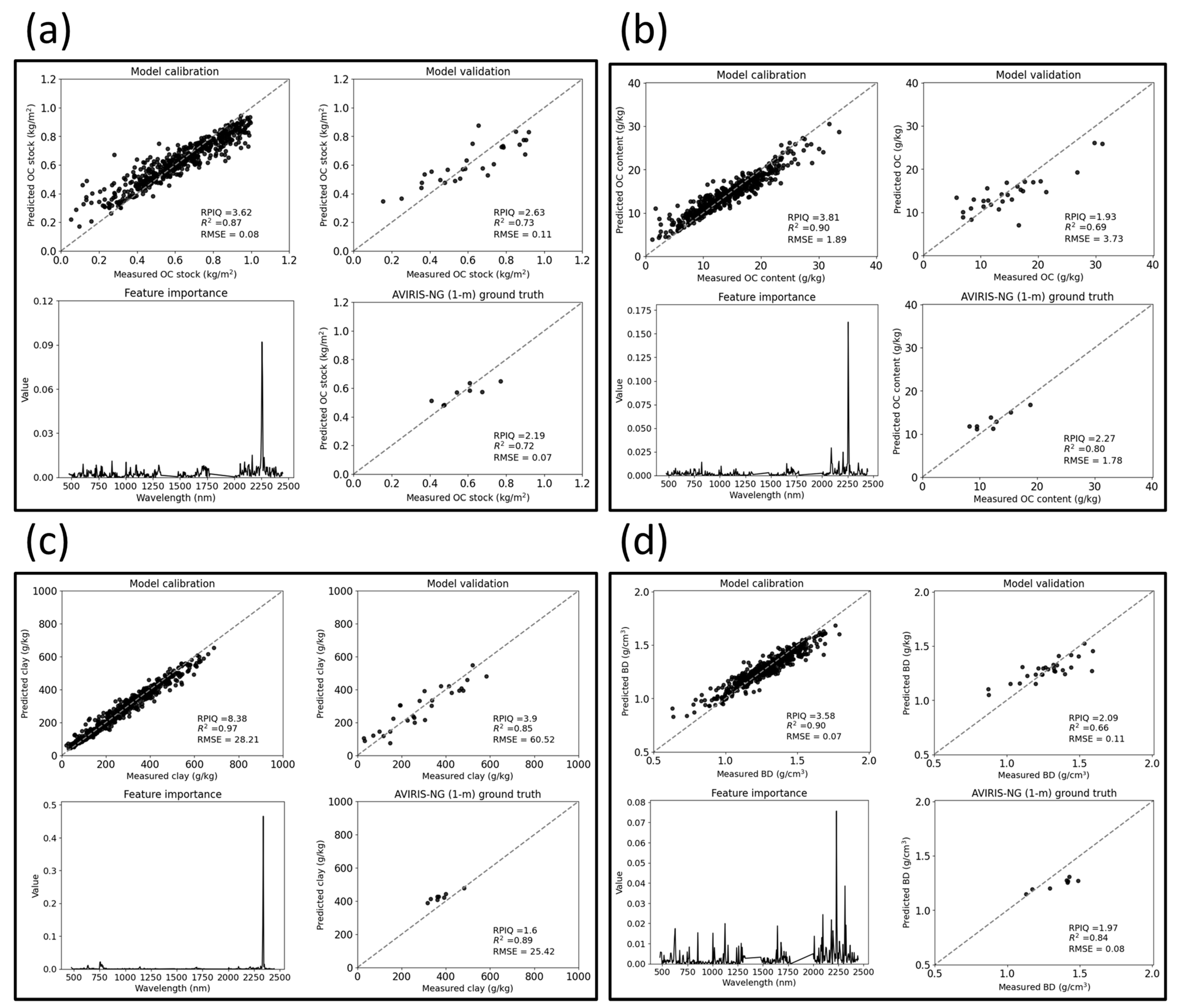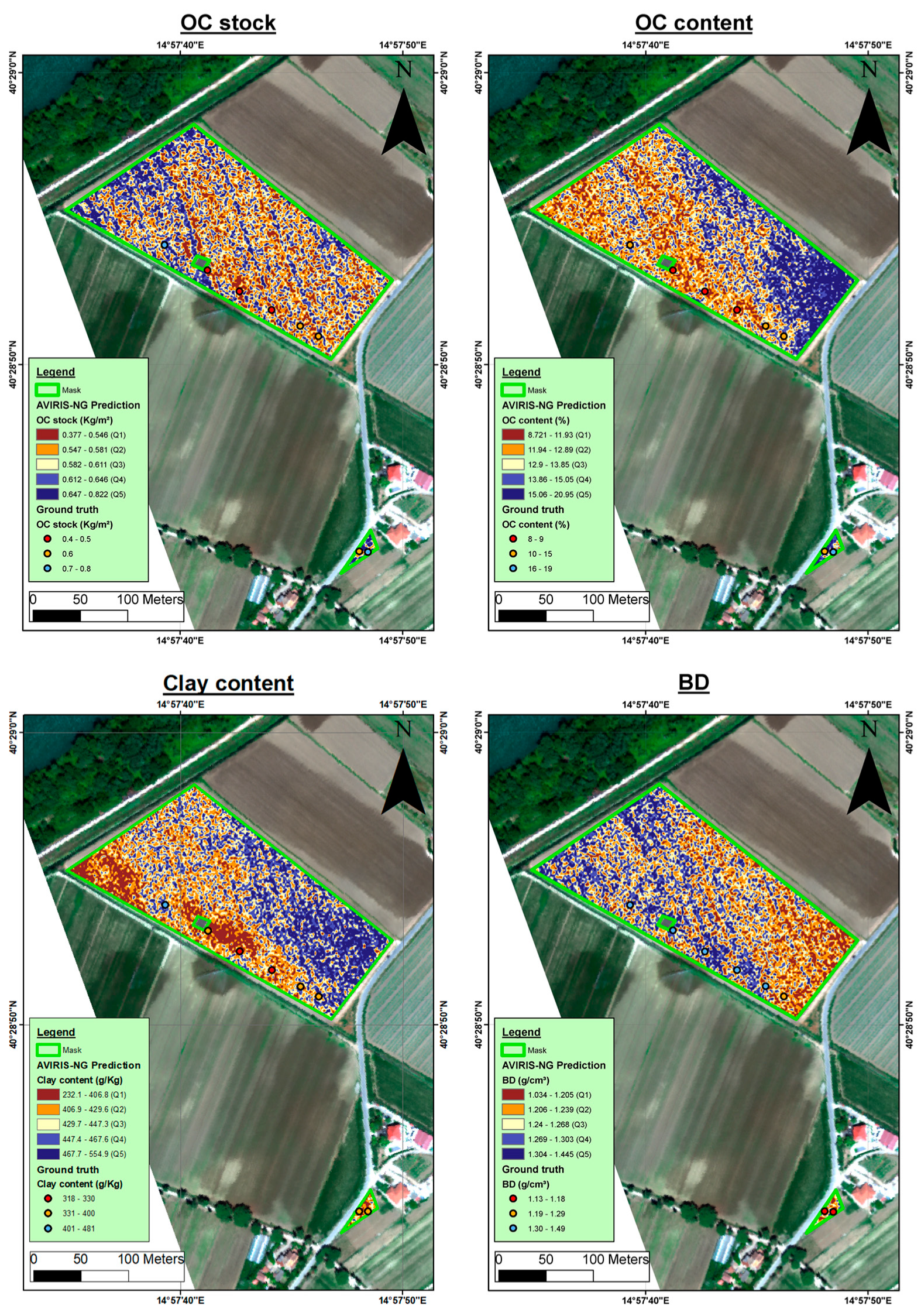Mapping Soil Organic Carbon Stock Using Hyperspectral Remote Sensing: A Case Study in the Sele River Plain in Southern Italy
Abstract
1. Introduction
2. Materials and Methods
2.1. Campania SSL
2.2. The Sele River Plain Study Site
2.3. Soil Physical and Chemical Analyses—Soil-Water Content Measurement
2.4. Laboratory Spectral Measurements
2.5. Field Measurements
- (a)
- A black polyethylene agricultural net lying over a bare soil area in the study site;
- (b)
- Stream water from the Sele River;
- (c)
- Corn crops;
- (d)
- Asphalt.
2.6. AVIRIS–NG Flight and Data
2.7. Data Analysis
- (a)
- Calibration;
- (b)
- Validation;
- (c)
- Ground truth.
3. Results
3.1. Correlation Matrices
3.2. Spectral Modeling Performance
3.3. Mapping Stage
4. Discussion
5. Conclusions
Author Contributions
Funding
Data Availability Statement
Acknowledgments
Conflicts of Interest
References
- Edenhofer, O. Climate Change 2014: Mitigation of Climate Change; Cambridge University Press: Cambridge, UK, 2015; Volume 3, ISBN 1-107-05821-X. [Google Scholar]
- Amelung, W.; Bossio, D.; de Vries, W.; Kögel-Knabner, I.; Lehmann, J.; Amundson, R.; Bol, R.; Collins, C.; Lal, R.; Leifeld, J. Towards a Global-Scale Soil Climate Mitigation Strategy. Nat. Commun. 2020, 11, 5427. [Google Scholar] [CrossRef]
- Francos, N.; Ogen, Y.; Ben-Dor, E. Spectral Assessment of Organic Matter with Different Composition Using Reflectance Spectroscopy. Remote Sens. 2021, 13, 1549. [Google Scholar] [CrossRef]
- Kuzyakov, Y.; Horwath, W.R.; Dorodnikov, M.; Blagodatskaya, E. Effects of Elevated CO2 in the Atmosphere on Soil C and N Turnover. In Developments in Soil Science; Elsevier: Amsterdam, The Netherlands, 2018; Volume 35, pp. 207–219. ISBN 0166-2481. [Google Scholar]
- Minasny, B.; Malone, B.P.; McBratney, A.B.; Angers, D.A.; Arrouays, D.; Chambers, A.; Chaplot, V.; Chen, Z.-S.; Cheng, K.; Das, B.S.; et al. Soil Carbon 4 per Mille. Geoderma 2017, 292, 59–86. [Google Scholar] [CrossRef]
- Venter, Z.S.; Hawkins, H.-J.; Cramer, M.D.; Mills, A.J. Mapping Soil Organic Carbon Stocks and Trends with Satellite-Driven High Resolution Maps over South Africa. Sci. Total Environ. 2021, 771, 145384. [Google Scholar] [CrossRef] [PubMed]
- Stockmann, U.; Padarian, J.; McBratney, A.; Minasny, B.; de Brogniez, D.; Montanarella, L.; Hong, S.Y.; Rawlins, B.G.; Field, D.J. Global Soil Organic Carbon Assessment. Glob. Food Secur. 2015, 6, 9–16. [Google Scholar] [CrossRef]
- Bahri, H.; Raclot, D.; Barbouchi, M.; Lagacherie, P.; Annabi, M. Mapping Soil Organic Carbon Stocks in Tunisian Topsoils. Geoderma Reg. 2022, 30, e00561. [Google Scholar] [CrossRef]
- Gomes, L.C.; Faria, R.M.; de Souza, E.; Veloso, G.V.; Schaefer, C.E.G.; Fernandes Filho, E.I. Modelling and Mapping Soil Organic Carbon Stocks in Brazil. Geoderma 2019, 340, 337–350. [Google Scholar] [CrossRef]
- Minasny, B.; McBratney, A.B.; Mendonça-Santos, M.; Odeh, I.; Guyon, B. Prediction and Digital Mapping of Soil Carbon Storage in the Lower Namoi Valley. Soil Res. 2006, 44, 233–244. [Google Scholar] [CrossRef]
- Minasny, B.; McBratney, A.B.; Malone, B.P.; Wheeler, I. Digital Mapping of Soil Carbon. Adv. Agron. 2013, 118, 1–47. [Google Scholar]
- Francos, N.; Chabrillat, S.; Tziolas, N.; Milewski, R.; Brell, M.; Samarinas, N.; Angelopoulou, T.; Tsakiridis, N.; Liakopoulos, V.; Ruhtz, T.; et al. Estimation of Water-Infiltration Rate in Mediterranean Sandy Soils Using Airborne Hyperspectral Sensors. CATENA 2023, 233, 107476. [Google Scholar] [CrossRef]
- Demattê, J.A.M.; Galdos, M.V.; Guimarães, R.V.; Genú, A.M.; Nanni, M.R.; Zullo, J., Jr. Quantification of Tropical Soil Attributes from ETM+/LANDSAT-7 Data. Int. J. Remote Sens. 2007, 28, 3813–3829. [Google Scholar] [CrossRef]
- Ben-Dor, E. Quantitative Remote Sensing of Soil Properties. In Advances in Agronomy; Academic Press: Cambridge, MA, USA, 2002; Volume 75, pp. 173–243. ISBN 0065-2113. [Google Scholar]
- Francos, N.; Notesco, G.; Ben-Dor, E. Estimation of the Relative Abundance of Quartz to Clay Minerals Using the Visible–Near-Infrared–Shortwave-Infrared Spectral Region. Appl. Spectrosc. 2021, 75, 882–892. [Google Scholar] [CrossRef]
- Demattê, J.A.M.; Dotto, A.C.; Paiva, A.F.S.; Sato, M.V.; Dalmolin, R.S.D.; de Araújo, M.d.S.B.; da Silva, E.B.; Nanni, M.R.; ten Caten, A.; Noronha, N.C.; et al. The Brazilian Soil Spectral Library (BSSL): A General View, Application and Challenges. Geoderma 2019, 354, 113793. [Google Scholar] [CrossRef]
- Ogen, Y.; Zaluda, J.; Francos, N.; Goldshleger, N.; Ben-Dor, E. Cluster-Based Spectral Models for a Robust Assessment of Soil Properties. Geoderma 2019, 340, 175–184. [Google Scholar] [CrossRef]
- Tziolas, N.; Tsakiridis, N.; Ogen, Y.; Kalopesa, E.; Ben-Dor, E.; Theocharis, J.; Zalidis, G. An Integrated Methodology Using Open Soil Spectral Libraries and Earth Observation Data for Soil Organic Carbon Estimations in Support of Soil-Related SDGs. Remote Sens. Environ. 2020, 244, 111793. [Google Scholar] [CrossRef]
- Toth, G.; Johnes, A.; Montanarella, L. LUCAS Topsoil Survey. Methodology, Data and Results; Publications Office of the European Union: Luxembourg, 2013; EUR26102—Scientific and Technical Research Series—ISSN 1831-9424 (Online); ISBN 978-92-79-32542-7. [Google Scholar] [CrossRef]
- Viscarra Rossel, R.A.; Behrens, T.; Ben-Dor, E.; Brown, D.J.; Demattê, J.A.M.; Shepherd, K.D.; Shi, Z.; Stenberg, B.; Stevens, A.; Adamchuk, V.; et al. A Global Spectral Library to Characterize the World’s Soil. Earth-Sci. Rev. 2016, 155, 198–230. [Google Scholar] [CrossRef]
- Stevens, A.; van Wesemael, B.; Bartholomeus, H.; Rosillon, D.; Tychon, B.; Ben-Dor, E. Laboratory, Field and Airborne Spectroscopy for Monitoring Organic Carbon Content in Agricultural Soils. Geoderma 2008, 144, 395–404. [Google Scholar] [CrossRef]
- Steven, M. Ground Truth an Underview. Int. J. Remote Sens. 1987, 8, 1033–1038. [Google Scholar] [CrossRef]
- Castaldi, F.; Chabrillat, S.; Jones, A.; Vreys, K.; Bomans, B.; Van Wesemael, B. Soil Organic Carbon Estimation in Croplands by Hyperspectral Remote APEX Data Using the LUCAS Topsoil Database. Remote Sens. 2018, 10, 153. [Google Scholar] [CrossRef]
- Thompson, D.R.; Boardman, J.W.; Eastwood, M.L.; Green, R.O.; Haag, J.M.; Mouroulis, P.; Van Gorp, B. Imaging Spectrometer Stray Spectral Response: In-Flight Characterization, Correction, and Validation. Remote Sens. Environ. 2018, 204, 850–860. [Google Scholar] [CrossRef]
- Nasta, P.; Bonanomi, G.; Šimůnek, J.; Romano, N. Assessing the Nitrate Vulnerability of Shallow Aquifers under Mediterranean Climate Conditions. Agric. Water Manag. 2021, 258, 107208. [Google Scholar] [CrossRef]
- Allocca, C.; Castrignanò, A.; Nasta, P.; Romano, N. Regional-Scale Assessment of Soil Functions and Resilience Indicators: Accounting for Change of Support to Estimate Primary Soil Properties and Their Uncertainty. Geoderma 2023, 431, 116339. [Google Scholar] [CrossRef]
- Ben Dor, E.; Francos, N.; Ogen, Y.; Banin, A. Aggregate Size Distribution of Arid and Semiarid Laboratory Soils (<2 Mm) as Predicted by VIS-NIR-SWIR Spectroscopy. Geoderma 2022, 416, 115819. [Google Scholar] [CrossRef]
- Mebius, L. A Rapid Method for the Determination of Organic Carbon in Soil. Anal. Chim. Acta 1960, 22, 120–124. [Google Scholar] [CrossRef]
- Gee, G.W.; Or, D. 2.4 Particle-size Analysis. Methods Soil Anal. Part 4 Phys. Methods 2002, 5, 255–293. [Google Scholar]
- Lazzaro, U.; Mazzitelli, C.; Sica, B.; Di Fiore, P.; Romano, N.; Nasta, P. On Evaluating the Hypothesis of Shape Similarity between Soil Particle-Size Distribution and Water Retention Function. J. Agric. Eng. 2023, 54, 1542. [Google Scholar] [CrossRef]
- Paruta, A.; Ciraolo, G.; Capodici, F.; Manfreda, S.; Sasso, S.F.D.; Zhuang, R.; Romano, N.; Nasta, P.; Ben-Dor, E.; Francos, N.; et al. A Geostatistical Approach to Map Near-Surface Soil Moisture Through Hyperspatial Resolution Thermal Inertia. IEEE Trans. Geosci. Remote Sens. 2020, 59, 5352–5369. [Google Scholar] [CrossRef]
- Nelson, R. Carbonate and Gypsum. Methods Soil Anal. Part 2 Chem. Microbiol. Prop. 1983, 9, 181–197. [Google Scholar]
- Wang, M.; Chen, H.; Zhang, W.; Wang, K. Soil Organic Carbon Stock and Its Changes in a Typical Karst Area from 1983 to 2015. J. Soils Sediments 2021, 21, 42–51. [Google Scholar] [CrossRef]
- Ben Dor, E.; Ong, C.; Lau, I.C. Reflectance Measurements of Soils in the Laboratory: Standards and Protocols. Geoderma 2015, 245–246, 112–124. [Google Scholar] [CrossRef]
- Nasta, P.; Palladino, M.; Sica, B.; Pizzolante, A.; Trifuoggi, M.; Toscanesi, M.; Giarra, A.; D’Auria, J.; Nicodemo, F.; Mazzitelli, C.; et al. Evaluating Pedotransfer Functions for Predicting Soil Bulk Density Using Hierarchical Mapping Information in Campania, Italy. Geoderma Reg. 2020, 21, e00267. [Google Scholar] [CrossRef]
- Palladino, M.; Romano, N.; Pasolli, E.; Nasta, P. Developing Pedotransfer Functions for Predicting Soil Bulk Density in Campania. Geoderma 2022, 412, 115726. [Google Scholar] [CrossRef]
- Calixto, E. Gas and Oil Reliability Engineering: Modeling and Analysis; Gulf Professional Publishing: Cambridge, MA, USA, 2016; ISBN 0-12-811173-9. [Google Scholar]
- Breiman, L. Random Forests. Mach. Learn. 2001, 45, 5–32. [Google Scholar] [CrossRef]
- Pedregosa, F.; Varoquaux, G.; Gramfort, A.; Michel, V.; Thirion, B.; Grisel, O.; Blondel, M.; Prettenhofer, P.; Weiss, R.; Dubourg, V.; et al. Scikit-Learn: Machine Learning in Python. J. Mach. Learn. Res. 2011, 12, 2825–2830. [Google Scholar]
- Savitzky, A.; Golay, M.J.E. Smoothing and Differentiation of Data by Simplified Least Squares Procedures. Anal. Chem. 1964, 36, 1627–1639. [Google Scholar] [CrossRef]
- Clark, R.N.; Roush, T.L. Reflectance Spectroscopy: Quantitative Analysis Techniques for Remote Sensing Applications. J. Geophys. Res. Solid Earth 1984, 89, 6329–6340. [Google Scholar] [CrossRef]
- Ludwig, B.; Murugan, R.; Parama, V.R.; Vohland, M. Accuracy of Estimating Soil Properties with Mid-infrared Spectroscopy: Implications of Different Chemometric Approaches and Software Packages Related to Calibration Sample Size. Soil Sci. Soc. Am. J. 2019, 83, 1542–1552. [Google Scholar] [CrossRef]
- Bellon-Maurel, V.; Fernandez-Ahumada, E.; Palagos, B.; Roger, J.-M.; McBratney, A. Critical Review of Chemometric Indicators Commonly Used for Assessing the Quality of the Prediction of Soil Attributes by NIR Spectroscopy. TrAC Trends Anal. Chem. 2010, 29, 1073–1081. [Google Scholar] [CrossRef]
- Rossel, R.A.V.; Behrens, T. Using Data Mining to Model and Interpret Soil Diffuse Reflectance Spectra. Geoderma 2010, 158, 46–54. [Google Scholar] [CrossRef]
- Francos, N.; Gedulter, N.; Ben-Dor, E. Estimation of Iron Content Using Reflectance Spectroscopy in a Complex Soil System After a Loss-on-Ignition Pre-Treatment. J. Soil Sci. Plant Nutr. 2023, 23, 6866–6873. [Google Scholar] [CrossRef]
- Olness, A.; Archer, D. Effect of Organic Carbon on Available Water in Soil. Soil Sci. 2005, 170, 90–101. [Google Scholar] [CrossRef]
- Francos, N.; Romano, N.; Nasta, P.; Zeng, Y.; Szabó, B.; Manfreda, S.; Ciraolo, G.; Mészáros, J.; Zhuang, R.; Su, B.; et al. Mapping Water Infiltration Rate Using Ground and UAV Hyperspectral Data: A Case Study of Alento, Italy. Remote Sens. 2021, 13, 2606. [Google Scholar] [CrossRef]








Disclaimer/Publisher’s Note: The statements, opinions and data contained in all publications are solely those of the individual author(s) and contributor(s) and not of MDPI and/or the editor(s). MDPI and/or the editor(s) disclaim responsibility for any injury to people or property resulting from any ideas, methods, instructions or products referred to in the content. |
© 2024 by the authors. Licensee MDPI, Basel, Switzerland. This article is an open access article distributed under the terms and conditions of the Creative Commons Attribution (CC BY) license (https://creativecommons.org/licenses/by/4.0/).
Share and Cite
Francos, N.; Nasta, P.; Allocca, C.; Sica, B.; Mazzitelli, C.; Lazzaro, U.; D’Urso, G.; Belfiore, O.R.; Crimaldi, M.; Sarghini, F.; et al. Mapping Soil Organic Carbon Stock Using Hyperspectral Remote Sensing: A Case Study in the Sele River Plain in Southern Italy. Remote Sens. 2024, 16, 897. https://doi.org/10.3390/rs16050897
Francos N, Nasta P, Allocca C, Sica B, Mazzitelli C, Lazzaro U, D’Urso G, Belfiore OR, Crimaldi M, Sarghini F, et al. Mapping Soil Organic Carbon Stock Using Hyperspectral Remote Sensing: A Case Study in the Sele River Plain in Southern Italy. Remote Sensing. 2024; 16(5):897. https://doi.org/10.3390/rs16050897
Chicago/Turabian StyleFrancos, Nicolas, Paolo Nasta, Carolina Allocca, Benedetto Sica, Caterina Mazzitelli, Ugo Lazzaro, Guido D’Urso, Oscar Rosario Belfiore, Mariano Crimaldi, Fabrizio Sarghini, and et al. 2024. "Mapping Soil Organic Carbon Stock Using Hyperspectral Remote Sensing: A Case Study in the Sele River Plain in Southern Italy" Remote Sensing 16, no. 5: 897. https://doi.org/10.3390/rs16050897
APA StyleFrancos, N., Nasta, P., Allocca, C., Sica, B., Mazzitelli, C., Lazzaro, U., D’Urso, G., Belfiore, O. R., Crimaldi, M., Sarghini, F., Ben-Dor, E., & Romano, N. (2024). Mapping Soil Organic Carbon Stock Using Hyperspectral Remote Sensing: A Case Study in the Sele River Plain in Southern Italy. Remote Sensing, 16(5), 897. https://doi.org/10.3390/rs16050897










